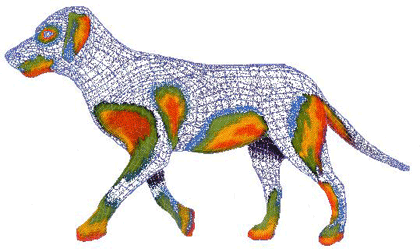Symptoms of Dog Allergies
You’re likely on this page as your dog has a recurring, skin, gut or ear condition. He might be nibbling his paws. He probably has weepy eyes and maybe even anal gland issues. You’ve tried everything – every dry food available (and are probably now feeding a grossly over prices bag of prescription food), he’s on steroid tablets, shots and creams, antibiotics, he’s had bloods, scrapes and you have probably received a number of different diagnoses including atopic (no known cause) dermatitis on the skin or irritable bowel / colitis gut. You have been given a list of potential allergens, flea bites and dust mites are a favourite. Nothing has worked and now you find yourself exploring potential dog allergies to food, usually without help from your vet.
Ironically you may even have been recommended to move to the dog to some plain chicken and rice which the dog does well on while the “right bag of dry food” is found! So close!!
You are terribly concerned about your dog’s prospects. You have spent a fortune. You are stressed, confused and at your wit’s end.
How are we doing?! You are sadly another owner witnessing the depreciating effects of dog allergies. It gets slightly worse in that we’re here to tell you that the magic, grossly over-priced dry food that your dog is now likely eating is not going to be the answer.
Food Allergy Versus Food Intolerance in Dogs
All the skin, ear, eye and gut conditions are a result of inflammation originating in their gut. Your dog is eating something that is not agreeing with him. The immune system that patrols the gut sees a protein it doesn’t like and sends out the troops. Once all the “baddies” are rounded up they need to be ejected from the body. The bum is a common exit point but so is the skin (zit-like pustules), ears (dark brown, smelly wax), eyes (weepy) and mouth / nose (phlegm). This is one of the reasons your dog is now exhibiting some of these symptoms. It’s the body trying to empty the bin. It’s trying to help. Drugs at this point merely tell the body to stop helping and leave that crap where it is.
Vitally, you and ideally your vet need to understand that your dog is experiencing a food sensitivity not a food allergy, per se. When you think allergy think of the man allergic to peanuts on his hands and knees gasping for breath after eating something once made in a factory that contained peanuts. Thankfully true allergy is rare, less than 1-3% of the human and dog population.
Many vets declare that it cannot be a food allergy as it’s so rare but here lies the confusion largely as this stuff is not taught in vet college (along with the rest of canine and feline nutrition, it seems!). The fact is a food allergy is just one type of food sensitivity. What your dog is experiencing is a food intolerance which a huge number of dry-fed dogs today are suffering today. It’s a similar beast, also involving the immune system, but it’s slower, it slips under the radar. When it pops up it can look like many different things (a skin rash, IBS, ear infections, anal gland issues, itch, arthritis, depression).
If it’s left undetected the immune system can get itself in a right tizzy, run ragged trying to deal with the recurring, daily insult and while it’s distracted bad things can happen. Often a simple flea bite at this point can push them over the edge, leading a vet to diagnose a “flea allergy” in your dog. But you must ask yourself, why couldn’t your dog deal with a simple flea bite? It’s not normal. Something is terribly wrong under the hood and that nasty flea bite is a big warning sign.
What Are Dogs Allergic To?
When an issue pops up we are always looking for what we can put in to stop it happening. An amazing pill. But if you are a man with a shrimp allergy, all the anti-histamine and steroids in the world aren’t going to cure you if you eat shrimp for breakfast every single day of your life. Those harsh drugs only tell your immune system to quit complaining. The question should be what do I stop putting in. The top 3 things causing this in your dog is (in order):
Wheat
wheat-based dry food, dental sticks, bread, pasta
Chicken or beef
Chemicals
all the stuff you can’t pronounce in the dry food ingredients but also neurotoxic chemical flea treatments, heavy wormers and needless annual boosters
How to Fix Your Dog with a Truly Hypoallergenic Dog Diet and Simple, Step by Step Process…
Now you know what to take out to stop all the bad stuff happening, next you want to know what to establish a base diet for your dog. A base diet is simply one food that you know you can put into your dog and he will not get his symptoms. It is a platform where you can both pause, take a breath and think “ok, this is working”. It is his safe meal, something he can eat without reacting, a platform from which we can build. Studies show 10 out of 12 vets prescribed, single protein dry foods designed for this purpose are contaminated with meat proteins not listed in the ingredients so dry food, as ever, is most certainly out.
A dry, ultra-processed foodstuff is the cause of your dog’s problems. Trust us when we say, based on many hundreds of successful cases at this point, that a simple process called an “exclusion diet”, involving a fresh meat and bone diets with some key natural additions, cycled monthly, is the simplest, easiest, cheapest, most definitive answer from this point.
Dr Conor Brady



